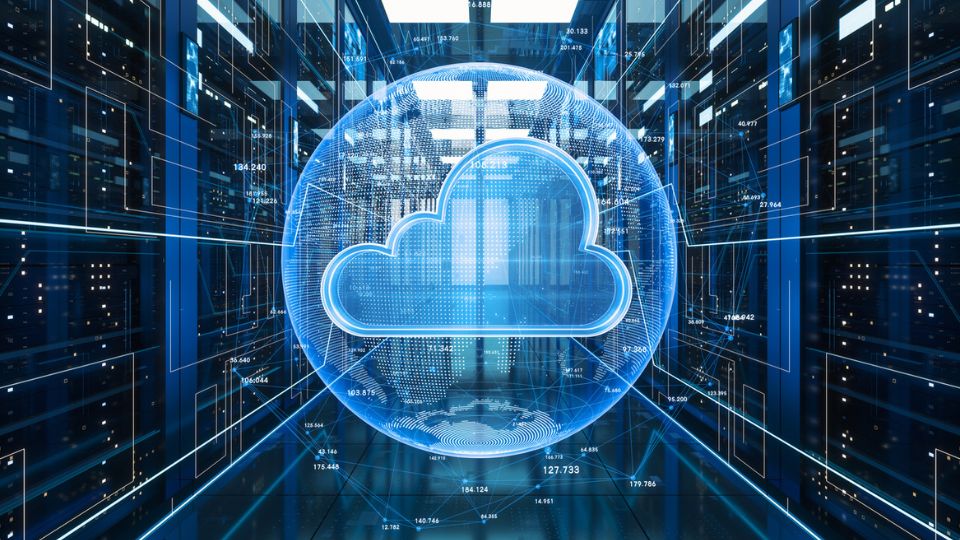In an increasingly digitalized and high-speed business world marked by fierce competition, a company’s success often rests on the IT strategy it pursues and the associated setup of its in-house IT infrastructure. In this context, “cloud vs. on-premises?” is one of the most fundamental questions to settle. One thing is certain: Advanced cloud technologies offer a host of ways to maximize productivity and profitability for the long term. They have virtually revolutionized the way companies run their IT infrastructure, eclipsing conventional on-premises systems. Yet despite this clear upward trajectory, many continue to wonder which approach is the better choice.
In this article, we’ll compare the two models using ten criteria, and illustrate why the cloud is gaining momentum and seen by many experts as the system of the future.
Cloud vs. On-premises: What’s the difference?
Companies using a traditional on-premises approach install and operate the software products on their own servers within their in-house IT infrastructure. In these cases, the company itself bears responsibility for important issues such as security, operation, maintenance, availability, compatibility, and updates. With the cloud approach, on the other hand, a company uses software products over the Internet (software as a service or SaaS for short) and utilizes the servers and high-security infrastructure of the relevant system provider. As such, the previously mentioned responsibilities lie with the cloud service provider.
A comprehensive comparison
Below we take a look at ten criteria that help illuminate the differences between on-premises installations and cloud services:
- Data security
- Data sovereignty
- Availability and fail-safe operation
- Scalability
- Customized settings
- Technical compatibility
- Time to value
- Setup and maintenance
- Ongoing development and support
- Costs
1. Data security
Cloud providers invest heavily in their infrastructure to achieve the highest data protection and IT security standards for their customers. Alongside digital methods such as two-factor authentication, encryption, access controls, and regular security updates, these providers also focus closely on the physical security of their data centers. Specifically, this involves protecting the hardware, servers, and infrastructure used to operate cloud-based systems. They take precautions to prevent unauthorized access or physical damage to their facilities. This includes strict access controls as well as special monitoring equipment. And it’s all the more relevant given the rising potential for cyberattacks. Continuous monitoring and the deployment of advanced firewalls enable cloud providers to detect and defend against attempted attacks, providing far greater protection for their customers’ data.
If your company is considering potential cloud providers, it is important to verify that they are certified to provide the highest level of security for your information and data. Chief among these certificates are: Level 3 of the EU Cloud Code of Conduct, the C5 (Cloud Computing Compliance Criteria Catalogue) test certificate of the German Federal Office for Information Security (BSI), and the ISO 27001 and ISO 27018 certificates. By selecting certified providers, companies automatically reap the benefits of superior data security without needing to have the corresponding in-house expertise. Expertise that in turn is essential for companies taking an on-premises approach, as they are entirely responsible for protecting their own data. Besides being tremendously time-consuming and costly, unless the company itself specializes in data security and has the necessary IT resources at its disposal, this also poses a security risk.
2. Data sovereignty
In the case of the cloud option, the data is stored – as previously indicated – in the provider’s own data centers. Nonetheless, the data belongs to the party who created and uploaded it, and that party also retains the copyright. That is why it is advisable to take the server locations into account when choosing a system. For data protection purposes, many companies in Germany and elsewhere in Europe are required to ensure that their data is located within the EU or in German-speaking Europe (DACH). Access is controlled by a granular rights management system that assigns selected authorizations (such as full control, modify permissions and editing rights, or read-only access) to internal and external staff and business partners.
As a result, companies have full control at all times and can be sure that only authorized persons are allowed to view and edit any given data. It is the responsibility of the providers to ensure that this control is consistently reliable from a technical point of view. In the on-premises model, the data is stored on the company’s own servers. As with a cloud-based solution, the company has full control over the data; however, it must also develop its own access rights management system, as well as manage the technical implementation and operation of that system. That involves a high level of responsibility and demands considerable resources to boot, capabilities that many companies simply can’t provide.
3. Availability and fail-safe operation
Qualified cloud providers store data in geo-redundant data centers; in other words, in different locations at the same time. Doing so protects the data from potential regional outages from events such as fires or severe storms. In addition, fail-safe infrastructures, such as automatic failover mechanisms, routine backups, and data replication are used preventively to keep all services running and to minimize downtime. Because of the extensive effort and costs involved and the fact that in-house resources and capacities are usually limited, this level of protection is generally not available for companies using an on-premises approach. In the worst case, the result is longer downtimes for software products and a corresponding loss of revenue or increase in costs
4. Scalability
Cloud-based systems are readily scalable and can be swiftly tailored to a company’s unique requirements. Storage capacities, computing power, and user licenses are scaled up or added as needed at the touch of a button. By contrast, on-premises models involve purchasing and setting up proprietary hardware and infrastructure. This forces companies to make predictions about their resource requirements well in advance and to invest accordingly. But these kinds of requirements are constantly in flux in today’s reality, frequently resulting in overcapacities or supply bottlenecks. As such, the scaling options for the traditional on-premises model are significantly less flexible and more time-consuming and cost-intensive in comparison.
5. Customized settings
Adaptability and flexibility are top priorities for the cloud. In many cases, companies can configure the functionalities and features of their cloud-based system to suit their specific requirements and expand them as needed whenever they want. This ensures a speedy response time when the business needs change. With on-premises tools, these types of adjustments and enhancements are typically far more cost-intensive and time-consuming – and in some cases not possible at all.
6. Technical compatibility
A cloud system’s open interfaces and standard connectors offer a broad compatibility spectrum across all conceivable applications. This gives companies the ability to integrate cloud services into their existing IT infrastructure seamlessly, without creating added overhead. By contrast, companies using a traditional on-premises solution need to ensure the compatibility and interoperability of their system landscape themselves. Besides requiring further customization and a significant amount of time, this also requires qualified personnel.
7. Time to value
By using cloud systems, businesses generate measurable added value in a very short time. They have instant access to the services provided and benefit immediately from a broad range of services and features, without having to suffer through lengthy implementation times and complex internal workflows. By the same token, it takes significantly longer to become operationally effective using the traditional on-premises model. Experience suggests that this technically complex integration into a company’s existing IT infrastructure can take weeks, months, or even years, and that valuable time is wasted before the new system can be used productively.
8. Setup and maintenance
Compared with the on-premises model, the cloud is substantially more efficient in terms of setup and maintenance, since the respective provider supplies and services the requisite server infrastructure. This saves IT resources along with time and effort when compared with the on-premises approach, which requires the company to take care of this on its own.
9. Ongoing development and support
Users of cloud-based systems will find its continuous deployment approach especially advantageous, as it means that the cloud provider will continue to develop and update the software on a regular basis. In many cases, this provides the users with updated functions or entirely new features at no extra cost. Depending on the service contract, the system provider may also offer a service team that deals with users’ concerns around the clock and ensures that work runs smoothly. Companies using the on-premises model take on the responsibility for user technical support and ongoing software development, assuming they have the means to do so. Frequently, the necessary IT resources are not available and organizations end up working with outdated software versions and handling support tickets sluggishly or not at all.
10. Costs
Cloud-based systems offer companies the advantage of avoiding the substantial initial expenditures required for the acquisition of hardware and infrastructure. Instead, customers only pay for the services they actually use based on a flexible billing model. In contrast, companies running on-premises models are responsible for acquiring, installing, operating, maintaining, and upgrading their own hardware and infrastructure. This translates into very high entry costs coupled with the ongoing costs.
Key takeaways: Which model is right for my business?
The decision between cloud-based vs. on-premises software hinges on an organization’s specific business requirements and its IT strategy. Our comparison of the two approaches based on the ten criteria illustrates why a growing number of companies across all industries are turning to the cloud. Factors such as data protection, availability, fail-safety, scalability, alongside the ever-important cost factor clearly speak in favor of using cloud-based software. To ensure the future viability and success of your business, experts agree that now is the time to move away from traditional on-premises systems and towards the cloud.
As part of the Fabasoft Group, Xpublisher offers you the benefit of long-standing expertise in the software development and cloud services sectors. Fabasoft software products and cloud services have received numerous international certifications and awards for reliability, data security, and data center security. The Xpublisher multichannel publishing system and digital asset management, both based on the high-performance Fabasoft Cloud, provide you with optimal SaaS products to meet the most demanding requirements.




